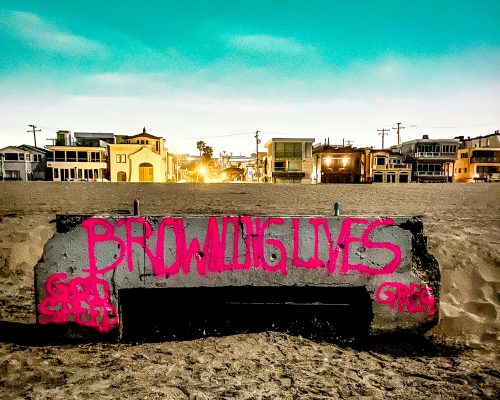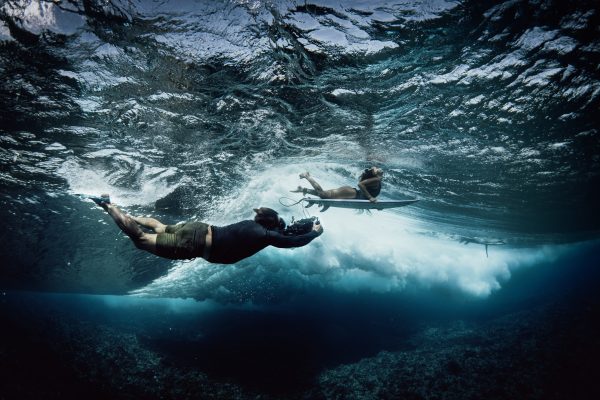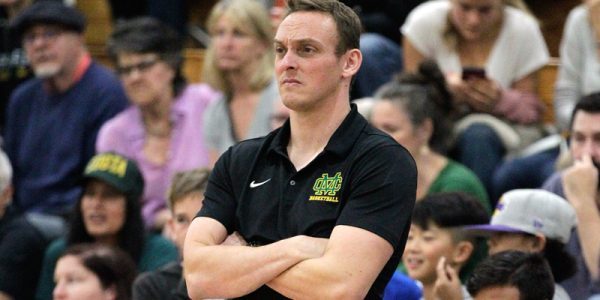
Horses in the wild? Elissa Kline’s “ghost herd” photographs are all that remain of when these majestic animals ran free
An array of equine images by Elissa Kline is on display in the group show “Finesse: Four Photographers,” through Oct. 27 at Zask Art Gallery in Rolling Hills Estates. Kline has turned her lens on a not unfamiliar subject, the horse, but this time there’s a poignant undertone.
As she writes in her artist statement, “When a friend accidentally witnessed a round-up of wild horses in the high desert near Challis, Idaho, she asked me to help tell their story. What I came to learn and witness was extraordinary.”
The pictures on view are life-size, closer to banners than framed portraits. They document her encounter, over a period of seven years, with these particular horses. It’s a story she feels very strong about, and here’s how it began:
“My friend, Bonnie Garman, witnessed a round-up in 2004 and was horrified by what she saw. She asked me to help her with an article on this particular herd of wild horses. Once I started photographing them, learning about them, watching them… I couldn’t stop going back to find them, even long after I delivered my assignment. I just couldn’t stop. Being out there with those wild magnificent beings was one of the greatest adventures of my life.”
On that first occasion, Kline says, she drove for many hours over washboard roads with her husband and son, straining their eyes until they finally saw little colored specks dotting the sage-covered plains. She didn’t get as close to the horses as she would later, but she did get close enough to feel the magic of being in their presence.
Kline points out that the Bureau of Land Management (BLM) oversees some 100,000-plus acres of public land in Idaho, occupied by wild horses. Like other animals having to fend for themselves they face a daily struggle for survival. While they have adapted to harsh winters and limited food sources, the largest threat comes from the competition for the land that they live on.
Kline knows horses, having cared for domestic breeds for much of her life. She and her husband co-managed and lived for 17 years on the ranch owned by songwriter Carole King. The ranch itself was near the public lands where the wild horses roamed. While King herself had no involvement in Kline’s project of photographing the horses, she certainly approved of the project.
“I suppose, though, that watching her fight for causes she believed in all these years (she is a well respected environmentalist) taught me how to speak out against what is not right.”
From the beginning, Kline was struck by the marked difference between domestic horses and the ones running free on the land.
“The wild horses are proud, self-sufficient, strong of hoof and beautiful beyond words,” she says.
“Unlike domestic horses, they don’t need us. Their connection to each other and the strength of their family ties was clearly evident, and long lasting. And there was the surprise, for me, that they didn’t stay in big herds,” as the Marlboro commercials would have us believe. “I watched family groups as small as three and as large as fifteen horses stay together year after year. I found that fascinating.”
Kline elaborates on her artist statement, which says that over the past four years she’s photographed maybe 100 horses, watching foals grow into strong yearlings but also older stallions getting pushed out of herds. More to the point, though, is that these animals are closely connected to one another.
Vanishing from the landscape
What was in the project that initially grabbed you, that held your passion and made you want to return again and again to document these animals?
“What initially grabbed me,” Kline replies, “was the staggering beauty and wildness of these horses. Visually, there was an incredible palette to work with. Every shade and color of horse – White, Brown, Red, Dapple Gray, Black, Appy, Paints – all set against the sage meadows, pine forests and red rock mountains. There was the knowledge that these horses didn’t need us to survive. They were doing fine on their own.
“In seven years photographing out in the wild, I never saw an unhealthy or skinny horse. I did see a few foals die soon after birth, but that is nature’s way. Survival of the fittest. I saw strong, healthy horses, with good hooves.
“The Challis horses are a mix of mustangs, cavalry horses and draft horses. Ranchers would often let their old work horses out and some obviously made it in the wild herds. There are a lot of horses that come from Grey Percheron stock.”
And there was something else: their look.
“The look in their eyes made me promise to them that I would do everything in my power to show people how beautiful, how gentle they are, and maybe that would help them stay on their land. Sadly, it did not, but I have at least documented their lives for a period of time when they were free.”
You mentioned that the horses are being rounded up because of greed. I imagine that this refers to the influx of cattle ranchers?
“Yes, it is cattle ranchers – hello Ken Salazar, a fifth generation rancher, head of the Department of the Interior, which is in charge of the BLM. However, they cost the taxpayers a bundle every year. And, really, eco-tourism could make great use of wild horses on public land… but that’s another story.”
In 1971, the Wild Free-Roaming Horses and Burros Act was signed into law by President Nixon. At the time, Nixon quoted Thoreau: “We need the tonic of wildness.” The act made it a federal crime to “capture, brand, harass, or kill wild horses on public lands.” Says Kline: “I never thought I’d utter the name Nixon in a positive light.”
Some numbers from the American Wild Horse Preservation campaign:
The 1971 Act mandates that wild horses be managed on 80 million acres of public lands.
Since 1971, wild horses have been completely removed from 40 million acres originally designated as management areas.
The current removal program is costing 60-plus million tax dollars a year.
The removal and processing of a single horse costs $5,000.
The public land cattle grazing program encompasses 259 million acres.
Private cattle outnumber wild horses about 150 to 1 on public lands.
Public land grazing accounts for only three percent of our national beef supply.
The public land grazing program costs over $100 million to manage annually.
The public land grazing program contributes typically a fraction of one percent of total income and employment throughout the West.
Some other figures noted by the American Wild Horse Preservation campaign:
In the 1800s, more than two million wild horses roamed the West, but today, less than 30,000 wild horses remain on public lands. Over 200,000 wild horses and burros have been removed from public lands since 1971. Currently, 32,000 captured horses are being held in government holding pens.
Sayings about “greener pastures” usually apply to humans, even though we’re not grazers by nature. Sanctuaries, where horses are removed to, could in theory be idyllic, but according to Kline it’s not that way at all.
“After the horses are rounded up,” she says, “they are brought to BLM holding facilities to be ‘processed’ before they are sent to either long-term holding [pens] or put on ‘the adoption pipeline.’
When they arrive at the holding corrals, these horses have been run five to ten, maybe more, miles in extreme weather conditions – heat of summer or dead of winter. They have been chased by helicopters, family bands smashed together in corrals at the loading site, stallions fighting, foals being trampled… sheer panic and fear. Then forcibly loaded into trailers…
“And now the real fun begins. Mares and foals are separated, yearlings and young mares and stallions separated from family bands, separated by age and sex; older stallions put together, panicked, fighting, everyone calling to each other. Close knit family destroyed. Foals as young as two months taken from their mothers and called ‘weanlings’ – in the wild they nurse for at least six months to a year. Many of the horses are injured, bruised, cut up, exhausted… and the stress of being separated from their herds is the final insult of a very bad day in the life of a once wild horse.”
Their lives on film
Being able to photograph the horses in the wild was not an easy task. Kline quickly learned “that it was best to go alone and to move slowly. Getting close enough to photograph the horses required tremendous patience. Intuitively, I learned to do what I call “the dance” – approach slowly, click some pictures while the horses watched me, curious, but cautious, assessing my presence. I learned when to turn my back to them, or to sit down in the tall sage. I sensed them bristle and anticipated when to walk away until they relaxed enough for me to approach again. Some days I didn’t see them at all. Other days, if I moved too fast, they ran away. The process was slow, but always magical.”
The way the work is hung and arranged in the gallery draws in the viewer. How did your photographs evolve into full-size fabric prints?
“While I was out in the sage, watching and photographing these magnificent animals, I kept wishing I could afford to print life size images.” That way, Kline says, “people could see what I was seeing. Small photos of the horses in their natural habitat do not do them justice. A happy fluke brought me to a woman who printed photos on fabric for her clothing designs. We worked together to print 7 foot by 3.5 foot cotton voile panels. I tried canvas and denim but the semi-translucent fabric supports my belief that these horses are disappearing. I call them my “ghost herd”. Of the horses you see in this exhibit, only one has remained on the land. All the others are gone – to long-term holding… or worse.
“It is my hope that these images convey the wonder that I felt while I was privileged to be in their presence,” Kline says, “and perhaps help shed some light on their right to live free.”
Zask Gallery is located at 550 Deep Valley Drive, Suite 151, in The Promenade on the Peninsula, in Rolling Hills Estates. “Finesse: Four Photographers” is up through Oct. 27 and also features work by Jason Speth, Hadi Salehi, and Gil Mares. For more information about Elissa Kline, go to elissakline.com. For the gallery, (310) 429-0973 or go to pszaskgallery.com. ER









